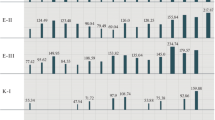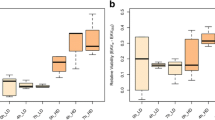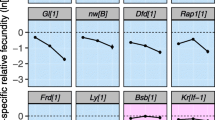Abstract
We have sampled wild chromosomes from two natural populations of Drosophila melanogaster and obtained flies fully homozygous for the second chromosome, the third chromosome, or both, as well as flies heterozygous for one or both wild chromosomes and balancer chromosomes. Rate of embryogenesis (egg laying to larval hatching) and rate of development from egg to adult are measured, by classifying the individuals into fast, intermediate, and slow developmental classes. The experiments indicate that variation for rate of embryogenesis and for rate of egg-to-adult development is plentiful in the natural populations. Various hypotheses are enunciated to account for the small range of phenotypic variation observed in wild-type individuals with respect to the two parameters (embryogenesis and egg-to-adult development) and for the difficulty in changing the mean rates by artificial selection. Appropriate experiments may decide among the hypotheses, helping us to understand the genetic control of rate of ontogenesis, which is an important fitness component.
Similar content being viewed by others
References
Cavener, D. R., 1983. The response of enzyme polymorphisms to developmental rate selection in Drosophila melanogaster. Genetics 105: 105–113.
Cole, L. C., 1954. The population consequences of life history phenomena. Quart. Rev. Biol. 29: 103–137.
Clarke, J. M., Maynard Smith, J. & Sodhi, K. C., 1961. Asymmetrical responses to selection for rate of development in Drosophila subobscura. Gen. Research 2: 70–81.
Dawson, S. P., 1966. Correlated responses to selection for developmental rate of Tribolium. Genetica 37: 63–77.
Dobzhansky, Th., 1970. Genetics of the evolutionary process. Columbia University Press, New York.
Dobzhansky, Th., Lewontin, R. C. & Pavlovsky, O., 1964. The capacity for increase in chromosomally polymorphic and monomorphic populations of D. melanogaster. Heredity 19: 597–614.
Gibson, J. B. & Thoday, J. M., 1963. Effects of disruptive selection. VIII. Imposed quasi-random mating. Heredity 18: 513–524.
Ives, P. T., 1945. The genetic structure of American populations of Drosophila melanogaster. Genetics 30: 167–196.
Kidwell, J. F. & Kidwell, M. M., 1966. The effect of inbreeding on body weight and abdominal chaeta number in Drosophila melanogaster. Can. J. genet. Cytol. 8: 207–215.
Lerner, I. M., 1954. Genetic homeostasis. Dover Publications, New York.
Lerner, I. M. & Dempster, R., 1951. Attenuation of genetic progress under continued selection in poultry. Heredity 5: 75–94.
Lewis, D., 1954. Gene-environment interaction: a relationship between dominance, heterosis, phenotypic stability and variability. Heredity 8: 333–356.
Lewontin, R. C., 1965. Selection for colonizing ability. In: The genetics of colonizing species (eds. H. G.Bauer & G. L.Stebbins). pp. 77–94. Academic Press, New York.
Marien, D., 1958. Selection for developmental rate of Drosophila pseudoobscura. Genetics 43: 3–15.
Marinković, D., 1967. Genetic loads affecting fertility in natural populations of D. pseudoobscura. Genetics 57: 701–709.
Marinković, D., 1977. A new model explaining the variation of quantitative traits. Genetika 9/1: 17–27.
Marinković, D. & Ayala, F. J. Selection for different rates of embryonic development in Drosophila melanogaster and Drosophila simulans. (submitted)
Mather, K., 1941. Variation and selection of polygenic characters. J. Genet. 41: 159–193.
Mather, K., 1942. The balance of polygenic combinations. J. Genet. 43: 309–335.
Mather, K., 1943. Polygenic inheritance and natural selection. Biol. Rev. 18: 32–64.
Mather, K., 1953. Genetic control of stability in development. Heredity 7: 297–336.
Mather, K. & Harrison, J. B., 1949. The manifold effect of selection. Heredity 3: 131–162.
Mather, K. & Jinks, J. L., 1982. Biometrical genetics. 3rd ed. Chapman and Hall, London.
Parsons, P. A., 1983. The evolutionary biology of colonizing species. Cambridge Univ. Press, Cambridge.
Prout, T., 1962. The effects of stabilizing selection on the time of development in Drosophila melanogaster. Genet. Research 3: 364–382.
Sang, J. H. & Clayton, G. A., 1957. Selection for larval development time in Drosophila. J. Hered. 48: 265–270.
Schultz, F. T. & Briles, W. E., 1953. The adaptive value of blood group genes in chickens. Genetics 38: 34–50.
Seager, R. D., Ayala, F. J. & Marks, R. W., 1982. Chromosome interactions in Drosophila melanogaster. II. Total fitness. Genetics 102: 485–502.
Thoday, J. M., 1953. Components of fitness. Symp. Soc. exp. Biol. 7: 96–113.
Tigerstadt, F. M. A., 1969. Experiments on selection for developmental rate in Drosophila melanogaster. Ann. Acad. Sci. Fenn., Ser. A/IV, 148: 1–53.
Author information
Authors and Affiliations
Rights and permissions
About this article
Cite this article
Marinkovic, D., Ayala, F.J. Genetic variation for rate of development in natural populations of Drosophila melanogaster . Genetica 71, 123–132 (1986). https://doi.org/10.1007/BF00058695
Received:
Accepted:
Issue Date:
DOI: https://doi.org/10.1007/BF00058695




